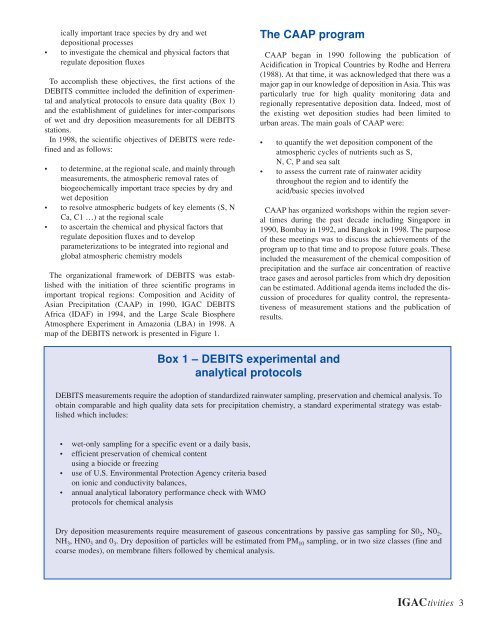Issue 27 Jan 2003 - IGAC Project
Issue 27 Jan 2003 - IGAC Project
Issue 27 Jan 2003 - IGAC Project
You also want an ePaper? Increase the reach of your titles
YUMPU automatically turns print PDFs into web optimized ePapers that Google loves.
ically important trace species by dry and wet<br />
depositional processes<br />
• to investigate the chemical and physical factors that<br />
regulate deposition fluxes<br />
To accomplish these objectives, the first actions of the<br />
DEBITS committee included the definition of experimental<br />
and analytical protocols to ensure data quality (Box 1)<br />
and the establishment of guidelines for inter-comparisons<br />
of wet and dry deposition measurements for all DEBITS<br />
stations.<br />
In 1998, the scientific objectives of DEBITS were redefined<br />
and as follows:<br />
• to determine, at the regional scale, and mainly through<br />
measurements, the atmospheric removal rates of<br />
biogeochemically important trace species by dry and<br />
wet deposition<br />
• to resolve atmospheric budgets of key elements (S, N<br />
Ca, C1 …) at the regional scale<br />
• to ascertain the chemical and physical factors that<br />
regulate deposition fluxes and to develop<br />
parameterizations to be integrated into regional and<br />
global atmospheric chemistry models<br />
The organizational framework of DEBITS was established<br />
with the initiation of three scientific programs in<br />
important tropical regions: Composition and Acidity of<br />
Asian Precipitation (CAAP) in 1990, <strong>IGAC</strong> DEBITS<br />
Africa (IDAF) in 1994, and the Large Scale Biosphere<br />
Atmosphere Experiment in Amazonia (LBA) in 1998. A<br />
map of the DEBITS network is presented in Figure 1.<br />
The CAAP program<br />
CAAP began in 1990 following the publication of<br />
Acidification in Tropical Countries by Rodhe and Herrera<br />
(1988). At that time, it was acknowledged that there was a<br />
major gap in our knowledge of deposition in Asia. This was<br />
particularly true for high quality monitoring data and<br />
regionally representative deposition data. Indeed, most of<br />
the existing wet deposition studies had been limited to<br />
urban areas. The main goals of CAAP were:<br />
• to quantify the wet deposition component of the<br />
atmospheric cycles of nutrients such as S,<br />
N, C, P and sea salt<br />
• to assess the current rate of rainwater acidity<br />
throughout the region and to identify the<br />
acid/basic species involved<br />
CAAP has organized workshops within the region several<br />
times during the past decade including Singapore in<br />
1990, Bombay in 1992, and Bangkok in 1998. The purpose<br />
of these meetings was to discuss the achievements of the<br />
program up to that time and to propose future goals. These<br />
included the measurement of the chemical composition of<br />
precipitation and the surface air concentration of reactive<br />
trace gases and aerosol particles from which dry deposition<br />
can be estimated. Additional agenda items included the discussion<br />
of procedures for quality control, the representativeness<br />
of measurement stations and the publication of<br />
results.<br />
Box 1 – DEBITS experimental and<br />
analytical protocols<br />
DEBITS measurements require the adoption of standardized rainwater sampling, preservation and chemical analysis. To<br />
obtain comparable and high quality data sets for precipitation chemistry, a standard experimental strategy was established<br />
which includes:<br />
• wet-only sampling for a specific event or a daily basis,<br />
• efficient preservation of chemical content<br />
using a biocide or freezing<br />
• use of U.S. Environmental Protection Agency criteria based<br />
on ionic and conductivity balances,<br />
• annual analytical laboratory performance check with WMO<br />
protocols for chemical analysis<br />
Dry deposition measurements require measurement of gaseous concentrations by passive gas sampling for S0 2 , N0 2 ,<br />
NH 3 , HN0 3 and 0 3 . Dry deposition of particles will be estimated from PM 10 sampling, or in two size classes (fine and<br />
coarse modes), on membrane filters followed by chemical analysis.<br />
<strong>IGAC</strong>tivities 3








